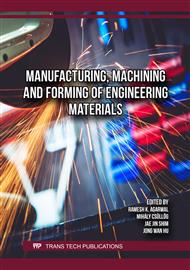[1]
Mazzanti, V. (2019). FDM 3D Printing of Polymers Containing Natural Fillers: A Review of their Mechanical Properties. Polymers, 11, pages 1-22.
DOI: 10.3390/polym11071094
Google Scholar
[2]
Dizon, J.R.C. (2018). Mechanical characterization of 3D-printed polymers - Review. Additive Manufacturing, 20, pages 44-67.
DOI: 10.1016/j.addma.2017.12.002
Google Scholar
[3]
Sharifah, I. S. S., Adnan, M. D. A., Nor Khairusshima, M. K., Shaffiar, N. M., & Buys, Y. F. (2018). Effect of thermoplastic polyurethane (TPU) on the thermal and mechanical properties of polylactic acid (PLA)/curcumin blends. IOP Conference Series: Materials Science and Engineering, 290(1).
DOI: 10.1088/1757-899X/290/1/012081
Google Scholar
[4]
Hong, H., Wei, J., Yuan, Y., Chen, F. P., Wang, J., Qu, X., & Liu, C. S. (2011). A novel composite coupled hardness with flexiblenessâpolylactic acid toughen with thermoplastic polyurethane. Journal of Applied Polymer Science, 121(2), 855–861.
DOI: 10.1002/app.33675
Google Scholar
[5]
Tran, V. H., Kim, J. D., Kim, J. H., Kim, S. K., & Lee, J. M. (2020). Influence of Cellulose Nanocrystal on the Cryogenic Mechanical Behavior and Thermal Conductivity of Polyurethane Composite. Journal of Polymers and the Environment, 28(4), 1169–1179.
DOI: 10.1007/s10924-020-01673-3
Google Scholar
[6]
Chen, Q., Mangadlao, J. D., Wallat, J., De Leon, A., Pokorski, J. K., & Advincula, R. C. (2017). 3D printing biocompatible polyurethane/poly(lactic acid)/graphene oxide nanocomposites: Anisotropic properties. ACS Applied Materials and Interfaces, 9(4), 4015–4023.
DOI: 10.1021/acsami.6b11793
Google Scholar
[7]
Rahmatabadi, D., Ghasemi, I., Baniassadi, M., Abrinia, K., & Baghani, M. (2022). 3D printing of PLA-TPU with different component ratios: Fracture toughness, mechanical properties, and morphology. Journal of Materials Research and Technology, 21, 3970–3981.
DOI: 10.1016/j.jmrt.2022.11.024
Google Scholar
[8]
Ambone, T., Torris, A., & Shanmuganathan, K. (2020). Enhancing the mechanical properties of 3D printed polylactic acid using nanocellulose. Polymer Engineering and Science, 60(8), 1842–1855.
DOI: 10.1002/pen.25421
Google Scholar
[9]
Kim, S., Yalla, S., Shetty, S., & Rosenblatt, N. J. (2022). 3D printed transtibial prosthetic sockets: A systematic review. PloS One, 17(10), e0275161
DOI: 10.1371/journal.pone.0275161
Google Scholar
[10]
Mondal, S. (2019). Cellulose Nanocrystal as a Prospective Reinforcement for Polymer Matrix Nanocomposites. In Encyclopedia of Renewable and Sustainable Materials (p.42–53). Elsevier.
DOI: 10.1016/b978-0-12-803581-8.11292-5
Google Scholar
[11]
Phanthong, P., Reubroycharoen, P., Hao, X., Xu, G., Abudula, A., & Guan, G. (2018). Nanocellulose: Extraction and application. In Carbon Resources Conversion (Vol. 1, Issue 1, p.32–43). KeAi Publishing Communications Ltd.
DOI: 10.1016/j.crcon.2018.05.004
Google Scholar
[12]
Ahmad, N. D., Kusmono, Wildan, M. W., & Herianto. (2023). Preparation and properties of cellulose nanocrystals-reinforced Poly (lactic acid) composite filaments for 3D printing applications. Results in Engineering, 17.
DOI: 10.1016/j.rineng.2022.100842
Google Scholar
[13]
Jing, X., Mi, H. Y., Salick, M. R., Cordie, T., Crone, W. C., Peng, X. F., & Turng, L. S. (2014). Morphology, mechanical properties, and shape memory effects of polylactic acid/ thermoplastic polyurethane blend scaffolds prepared by thermally induced phase separation. Journal of Cellular Plastics, 50(4), 361–379.
DOI: 10.1177/0021955X14525959
Google Scholar
[14]
Tao, Y., Kong, F., Li, Z., Zhang, J., Zhao, X., Yin, Q., Xing, D., & Li, P. (2021). A review on voids of 3D printed parts by fused filament fabrication. In Journal of Materials Research and Technology (Vol. 15, p.4860–4879). Elsevier Editora Ltda.
DOI: 10.1016/j.jmrt.2021.10.108
Google Scholar
[15]
Hsueh, M. H., Lai, C. J., Wang, S. H., Zeng, Y. S., Hsieh, C. H., Pan, C. Y., & Huang, W. C. (2021). Effect of printing parameters on the thermal and mechanical properties of 3D-printed PLA and PETG, using fused deposition modeling. Polymers, 13(11).
DOI: 10.3390/polym13111758
Google Scholar
[16]
Stenvall, E., Flodberg, G., Pettersson, H., Hellberg, K., Hermansson, L., Wallin, M., & Yang, L. (2020). Additive manufacturing of prostheses using forest-based composites. Bioengineering, 7(3), 1–18.
DOI: 10.3390/bioengineering7030103
Google Scholar


